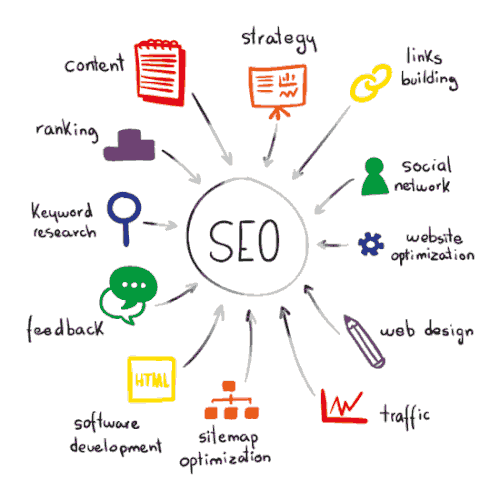SEO (SEARCH ENGINE OPTIMIZATION)
Engaging in a natural search strategy is probably the first thing you can do to get more free traffic to your website. Unlike paid online advertising methods (for example, Google AdWords, Facebook, LinkedIn) which stop being broadcast as soon as you stop paying, this one continues to send leads long after you have clicked on “Publish” ”.
That said, many companies avoid SEO because it sounds intimidating. The good news? This is not the case. Once an agency or developer has designed your site to be user-friendly, you can easily learn how to choose the right keywords and optimize your pages.
1. Optimize pages for search
Each web page or blog article should ideally focus on two long-tail keywords. What do we mean by “long tail”? It is a group of keywords that relate to the same idea. Let’s take a few examples on the house theme: building, building, villa, property, home, apartment, dining room, room, etc.
So your keywords should be included in the following locations:
The URL;
The title of the page;
In the content;
In the image ALT;
The Meta description;
Heading tags.
2. Increase links
Acquiring a large number of internal links and backlinks is part of improving your SEO and therefore your Google search ranking. Internal links are the links you create yourself, directing readers to other content on your own site.
Fortunately, it is quite easy to increase the number of internal links on your site. However, it is even easier when you work with groups of subjects which allow you to easily and naturally create links between them. Not only will this help your SEO services, but at the same time, you will give more user experience (UX).
On the other hand, getting backlinks from an authority website is more complicated. Your articles must deserve it, so they must be relevant and above all, precious in the eyes of others. They will then be encouraged to share them and possibly create links to them. Besides, do some personal awareness. Perhaps a blogger will be happy to mention your site in one of these blog articles. In short, a lot of work awaits you.
3. Evaluate site performance
Did you know that Google rewards fast-loading websites?
As the content of websites grows, it is not uncommon for site performance to slow down. Consequently, there will be enough impact on your SEO. This is why it is preferable to reduce the size of the images to be inserted in the sites. Also, remove unnecessary plug-ins and features. Finally, use a quality content distribution network (CDN). All of this can only optimize its performance.
4. Choose better keywords
As mentioned earlier, special attention should be paid to the choice of keywords. Target something too competitive, and you will be immediately discouraged by your lack of results. Target something too easy, and you won’t get enough traffic to make it worth it.
What to do? So opt for a mix of medium difficulty and long-tail keywords, with a mix between “quick wins” and “ambitious terms” thrown in to measure your results. There is a lot to be said about this; the next article will be dedicated to it.
5. Remove bad backlinks
Do you remember those quality backlinks we talked about earlier? Well, what we haven’t mentioned is that backlinks from flawed sources are a source of nuisance to SEO.
Use tools like Ahrefs, Majestic or Open Site Explorer to find and eliminate these bad backlinks.
